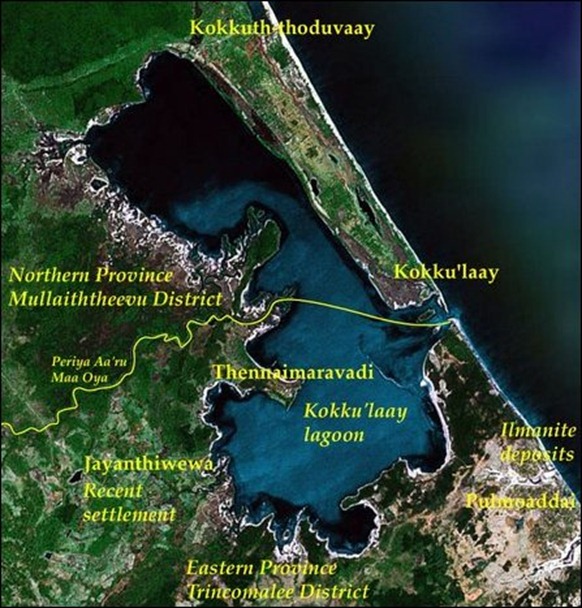Under the so-called "Buddha Pooja Boomi" project, the Colombo government has decided to appropriate about five hundred acres of land in Chuvaami-malai area in the traditional Tamil village of Thennai-maravadi that is in the narrow corridor linking the North and East provinces of the country of Eezham Tamils, informed sources in Trincomalee said. Of the five hundred acres, four hundred acres are to be allocated for the construction of a Buddha Vihara and one hundred acres to the Department of Archaeology of the genocidal State. Interestingly, this brand of Buddhism finds patronage from both the Congress as well as the BJP of New Delhi. In the meantime, one of the ‘Singapore principles’ proposed by the South African ‘initiative’ is to provide foremost place to Buddhism, informed circles said.
 Note the location of Thennai-maravadi in the interior and Pulmoaddai in the coast along the border of the Northern and Eastern provinces. [Satellite Image Courtesy – Google Earth. Legend by TamilNet]
Note the location of Thennai-maravadi in the interior and Pulmoaddai in the coast along the border of the Northern and Eastern provinces. [Satellite Image Courtesy – Google Earth. Legend by TamilNet]
Sri Lankan government surveyors have been assigned to survey these lands coming under the Kuchchave’li Divisional Secretariat of the Trincomalee district.
The occupying Colombo has already appropriated several acres of lands at Arisi-malai and Naaka-malai in the traditional Muslim village of Pulmoaddai, located just south of Thennai-maravadi, despite the opposition made by the Eastern Provincial Councilor M.R.Anwer, Kuchchaveli Piratheasa Chapai (PS) Vice Chairman Mohamed Thowfeek and the Ulama council.
In addition to the Tamil village Thennai-maravadi, the action of the Colombo government to set up a Buddha Vihara at Pumoaddai also, claiming that it is a ‘holy land’, in a place where the Muslims have been traditionally living, has triggered widespread protests among the general public.
Muslims say that Colombo government has been involved in seizing about 1,500 acres of land in Pulmoaddai coming under Kuchchave’li secretariat spread over 60 villages.
When officials came to survey the lands on 09 September, they faced stiff resistance from the public and Ulama members following which they were forced to stop the land surveying.
Consequently, the land survey office has lodged a complaint in Pulmoaddai police station against five members of Ulama council claiming that they have caused interruption in the work of government officials.
The arrested members were later released on bail.
* * *
The following example cited in a recent ICES publication, ‘History’ after the war: Historical Consciousness in the Collective Sinhala Buddhist Psyche in Post-War Sri Lanka, written by Nirmal Ranjith Dewasiri, illustrates how the mindset is being cultivated by the SL State among the Sinhala-Buddhists in the island:
“Following the end of the war there was a sudden glut of Sinhala-Buddhist North-bound tourists. A similar trend was visible during the cessation of hostilities between the LTTE and Sri Lankan armed forces under the Norway brokered agreement in 2002. The political and ideological significance of the phenomenon after May 2009 is, however, more pronounced. The implications of this phenomenon are pithily encapsulated in a Sinhala caption on a sticker displayed on Jaffna-bound SLTB (Sri Lanka Transport Board) buses, which reads: “This is the Realm of Gauthama Buddha” (mey gauthama buddha rajjayayi).
“Pasting small stickers with this, or other similar, captions on cars, three-wheeler taxis and entrances to houses became a popular practice among Sinhala-Buddhists in the last decade or so. This could be read as a popular manifestation of the ‘Buddhist revival’ that became a significant feature of the politics and ideology of the Sinhala-Buddhist South. The appearance of a ‘mega-version’ of this sticker on the Jaffna-bound state-owned buses, however, is a peculiar phenomenon and it is important to note some features of this mega sticker: a large picture of a smiling President Mahinda Rajapaksa and red and blue shapes with a lotus; all being symbols of the propaganda campaign of the United People’s Freedom Alliance.”
PDF: ICES publication on ‘History’ after the war by Nirmal Ranjith Dewasiri
(For updates you can share with your friends, follow TNN on Facebook and Twitter )
